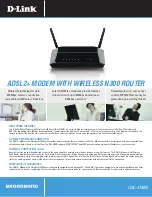
different composition of the `ON' part of the ring. The U-1496 series modems can distinguish up
to four types of ring signals and can be commanded to answer or not answer to any one of these
four types of ring signals. Following is a list of these four types of ring signals. These are the ring
types used in the USA. The difference between the ring types is on the 2-second ON part of the
ring signal. It comprises a long, double short, or triple short ring.
Type 1: 1.2S or 2S on; 4S off.
Type 2: 0.8S on, 0.4S off, 0.8S on; 4S off.
Type 3: 0.4S on, 0.2S off, 0.4S on, 0.2 S off, 0.8S on; 4S off.
Type 4: 0.3S on, 0.2S off, 1 S on, 0.2 S off, 0.3S on; 4S off.
S-Register S40 bit 3-6 are used for distinctive ring control. Each bit controls the answering of a
particular ring type. Set the bit to '1' to enable answering, set it to `0' to reject the ring. Note that
the ring may still be heard and a ring message sent to the terminal even if it is not counted as an
accepted ring by the modem. The control relationships between bits in S40 and different ring
types are:
Bit 3 - Ring type 1
Bit 4 - Ring type 2
Bit 5 - Ring type 3
Bit 6 - Ring type 4
If all of these bits are `0', any ring with a duration longer than 100 ms will be accepted. Use this
default if you do not have distinctive ring service.
If more than one type of Distinctive Ring is turned on, RING n will be reported for an incoming
ring signal where n is the ring type number.
Other countries may have different specifications for different types of ring. The manufacturer
may append other sets of ring type specifications to suit other countries' needs.
V.25bis COMMAND SET
V.25bis is a dialing command set standard defined by CCITT. It supports both asynchronous and
synchronous dialing. People use AT command dialing in most asynchronous cases because it is
widely used and supports many more functions than dialing. However, AT command only
supports asynchronous dialing and V.25bis is used in many synchronous dialing situations.
Synchronous V.25bis dialing is used in many IBM mainframe and mini environments where
synchronous communication is used. It is supported by the communication software on the
computer.
The U-1496 series modems supports both asynchronous and synchronous V.25bis dialing.
However, the internal card supports only asynchronous mode because it is asynchronous only
with its built-it asynchronous serial port. The modem supports the bit-oriented HDLC (High-level
Data Link Control) synchronous protocol which is used in most synchronous communication
links. Appendix C lists the supported V.25bis commands/indications and their formats.
Use AT*I1 to enable V.25bis commands. For synchronous applications, normally the modem is
permanently used for one application. Save the desired settings in the power-on profile and the
modem will be initialized to synchronous mode (&M3) with V.25bis command enabled (*I1) when
powered on. The V.25bis command set is also selectable through the U-1496's LCD panel menu.
A special command RST is provided to get the modem back to asynchronous AT command
mode from V.25bis mode. You can enter this RST command in either synchronous or















































